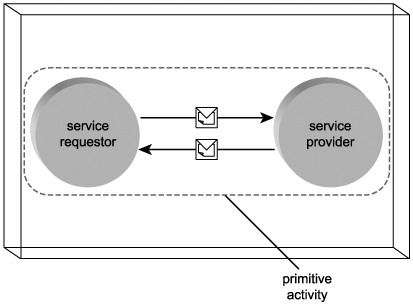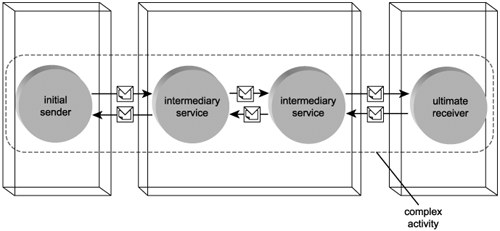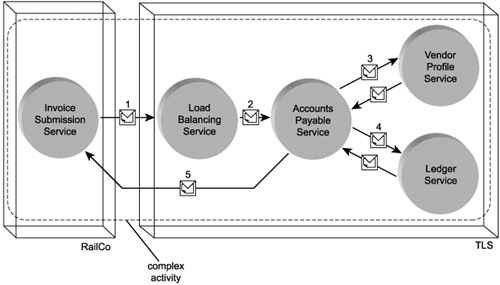Service activity
The completion of business tasks is an obvious function of any automated solution. Tasks are comprised of processing logic that executes to fulfill a number of business requirements. In service-oriented solutions, each task can involve any number of services. The interaction of a group of services working together to complete a task can be referred to as a service activity (Figure 6.10).
Figure 6.10. In an activity, multiple Web services collaborate to do a specific piece of work.

Note
Though there is no formal definition of the term "activity," it is used by several of the specifications we discuss in this book. It is a generic term that is most frequently associated with a logical unit of work completed by a collection of services.
6.2.1. Primitive and complex service activities
The scope of an activity can drastically vary. A simple or primitive activity is typified by synchronous communication and therefore often consists of two services exchanging information using a standard request-response MEP (Figure 6.11). Primitive activities are almost always short-lived; the execution of a single MEP generally constitutes the lifespan of a primitive activity.
Figure 6.11. A primitive service activity consisting of a simple MEP.

Complex activities, on the other hand, can involve many services (and MEPs) that collaborate to complete multiple processing steps over a long period of time (Figure 6.12). These more elaborate types of activities are generally structured around extension-driven and composition-oriented concepts, such as choreography and orchestration. However, a business task automated by a series of custom-developed services and without the use of a composition extension can just as easily be classified a complex activity.
Figure 6.12. A complex activity involving four services.

6.2.2. Service activities and SOA
In SOAs, activities represent any service interaction required to complete business tasks. The scope of a service activity is primarily concerned with the processing and communication between services only. The underlying application logic of each Web service, whether it consists of a single component or an entire legacy system, is generally not mapped as part of a service activity. Complex activities are commonplace in larger service-oriented solutions and can involve numerous participating services.
Note
The term "Web services activity" also happens to represent the ongoing Web services-related work being performed by numerous W3C working groups.
Case StudyThe message path traveled by a RailCo invoice submission is a great example of a complex activity. Here is a recap of the Invoice Submission Process we introduced in Chapter 5:
Collectively, these processing steps constitute a complex activity involving five services (Figure 6.13). Figure 6.13. A sample complex activity spanning RailCo and TLS boundaries. 
|
|
SUMMARY OF KEY POINTS |
|---|
|
Introduction
- Why this book is important
- Objectives of this book
- Who this book is for
- What this book does not cover
- How this book is organized
- Additional information
Case Studies
- Case Studies
- How case studies are used
- Case #1 background: RailCo Ltd.
- Case #2 background: Transit Line Systems Inc.
Part I: SOA and Web Services Fundamentals
Introducing SOA
- Introducing SOA
- Fundamental SOA
- Common characteristics of contemporary SOA
- Common misperceptions about SOA
- Common tangible benefits of SOA
- Common pitfalls of adopting SOA
The Evolution of SOA
- The Evolution of SOA
- An SOA timeline (from XML to Web services to SOA)
- The continuing evolution of SOA (standards organizations and contributing vendors)
- The roots of SOA (comparing SOA to past architectures)
Web Services and Primitive SOA
- Web Services and Primitive SOA
- The Web services framework
- Services (as Web services)
- Service descriptions (with WSDL)
- Messaging (with SOAP)
Part II: SOA and WS-* Extensions
Web Services and Contemporary SOA (Part I: Activity Management and Composition)
- Web Services and Contemporary SOA (Part I: Activity Management and Composition)
- Message exchange patterns
- Service activity
- Coordination
- Atomic transactions
- Business activities
- Orchestration
- Choreography
Web Services and Contemporary SOA (Part II: Advanced Messaging, Metadata, and Security)
- Web Services and Contemporary SOA (Part II: Advanced Messaging, Metadata, and Security)
- Addressing
- Reliable messaging
- Correlation
- Policies
- Metadata exchange
- Security
- Notification and eventing
Part III: SOA and Service-Orientation
Principles of Service-Orientation
- Principles of Service-Orientation
- Service-orientation and the enterprise
- Anatomy of a service-oriented architecture
- Common principles of service-orientation
- How service-orientation principles inter-relate
- Service-orientation and object-orientation (Part II)
- Native Web service support for service-orientation principles
Service Layers
- Service Layers
- Service-orientation and contemporary SOA
- Service layer abstraction
- Application service layer
- Business service layer
- Orchestration service layer
- Agnostic services
- Service layer configuration scenarios
Part IV: Building SOA (Planning and Analysis)
SOA Delivery Strategies
- SOA Delivery Strategies
- SOA delivery lifecycle phases
- The top-down strategy
- The bottom-up strategy
- The agile strategy
Service-Oriented Analysis (Part I: Introduction)
- Service-Oriented Analysis (Part I: Introduction)
- Service-oriented architecture vs. Service-oriented environment
- Introduction to service-oriented analysis
- Benefits of a business-centric SOA
- Deriving business services
Service-Oriented Analysis (Part II: Service Modeling)
- Service-Oriented Analysis (Part II: Service Modeling)
- Service modeling (a step-by-step process)
- Service modeling guidelines
- Classifying service model logic
- Contrasting service modeling approaches (an example)
Part V: Building SOA (Technology and Design)
Service-Oriented Design (Part I: Introduction)
- Service-Oriented Design (Part I: Introduction)
- Introduction to service-oriented design
- WSDL-related XML Schema language basics
- WSDL language basics
- SOAP language basics
- Service interface design tools
Service-Oriented Design (Part II: SOA Composition Guidelines)
- Service-Oriented Design (Part II: SOA Composition Guidelines)
- Steps to composing SOA
- Considerations for choosing service layers
- Considerations for positioning core SOA standards
- Considerations for choosing SOA extensions
Service-Oriented Design (Part III: Service Design)
- Service-Oriented Design (Part III: Service Design)
- Service design overview
- Entity-centric business service design (a step-by-step process)
- Application service design (a step-by-step process)
- Task-centric business service design (a step-by-step process)
- Service design guidelines
Service-Oriented Design (Part IV: Business Process Design)
- Service-Oriented Design (Part IV: Business Process Design)
- WS-BPEL language basics
- WS-Coordination overview
- Service-oriented business process design (a step-by-step process)
Fundamental WS-* Extensions
- Fundamental WS-* Extensions
- You mustUnderstand this
- WS-Addressing language basics
- WS-ReliableMessaging language basics
- WS-Policy language basics
- WS-MetadataExchange language basics
- WS-Security language basics
SOA Platforms
Appendix A. Case Studies: Conclusion
EAN: 2147483647
Pages: 150
